Nathan "BlackRain79" William – Today I'm going to give you seven easy ways to tell if somebody is good at poker. Use these seven simple clues to identify the weaker players at the table, and then you'll know who to target at the poker table—who to get in the pots against because you're going to win the most money from them.
Counting down from seven to one, here we go.
#7: Pay Attention to Kickers
Having played this game professionally for over a decade and having coached hundreds of students in small and mid-stakes games, this is one of the clearest tells I have seen repeatedly that quickly lets me know who the amateur players are and who the serious poker players are. Your kicker at the poker table is the other card in your hand when you hit top pair. For example, if the flop comes down with a , and you've got , you've hit top pair with your .
Now, what is important here is the other card in your hand.

A lot of weaker players will play hands like , , or . I’m not saying you should never play those hands; I have many videos here on the channel discussing the time and place to play those hands. However, many amateurs tend to overplay these hands, while professionals like myself take advantage of them again and again because we're only playing stronger kings like or . You can see the very simple math on your screen: is 87% to win versus in a situation like this. Bottom line: you are not going to be able to fight the math this hard in poker—or anything in life—and expect to win. If you want to start quickly improving your results in this game, make sure you're playing the right hands so you have the odds in your favor. I'll show you what hands to play in just a few minutes.
#6: Basic Pre-Flop Hand Reading
EP stands for early position, MP stands for middle position. The two best seats at the poker table are the ones in green—the cutoff and the button.
The reason why those are so profitable is that you're likely to act last on the flop, turn, and river. In a game of incomplete information like poker, getting to see what somebody else does first is always a massive advantage.
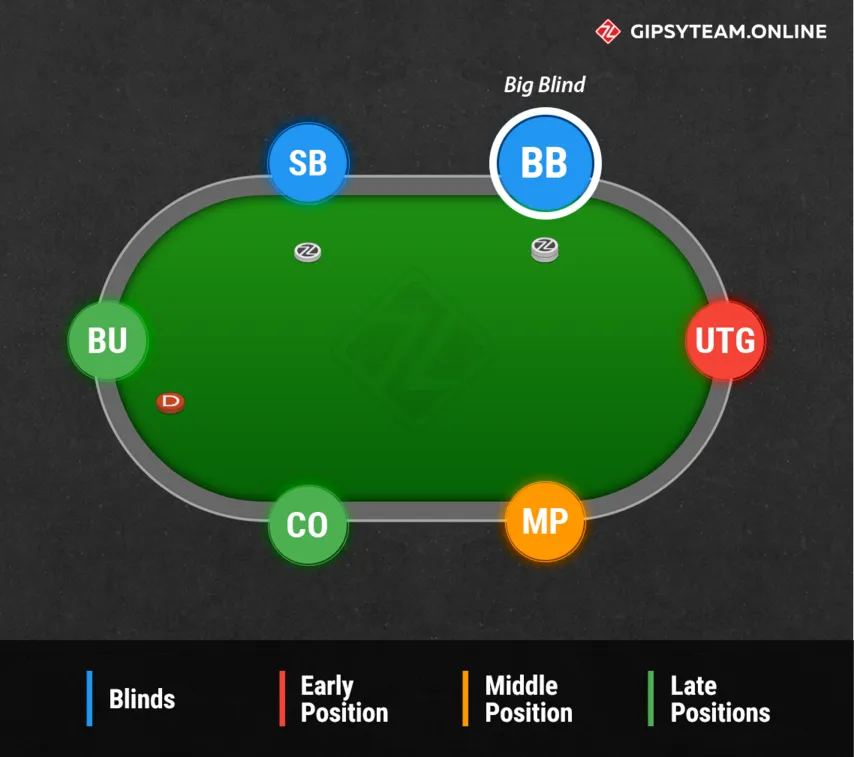
Before the flop in poker, it starts from EP and goes around the table; then in the post-flop streets, it starts from the small blind. I know it might be a little confusing for beginners right now, but bear with me here. Before the flop, you've just got your two cards. When somebody raises from EP or MP, you want to respect these raises because they are acting first—meaning they know they have the whole table left to act behind them—and therefore they're likely to have a strong hand.
I hope you can see the logical pieces of this puzzle and how expert semi-pro and professional poker players reconstruct the basic reasoning patterns that most people use in this game. When somebody raises from EP or MP, it's likely to be a strong hand. Now let’s move on to the button and cutoff; this is likely to be a weak hand because most people are just trying to steal the blinds.
Basically, when somebody raises from the button or cutoff, I don’t respect it too much. Finally, from the blinds: if it’s folded all the way around the table and somebody raises from the small blind while I’m sitting in the big blind, I'm not going to respect that too much either because I know they realize they only have one person left to beat; therefore they're going to raise with a much wider range.
Once again, I don’t want to confuse newer players; believe me when I say this sort of logical reasoning does come naturally as you gain more experience in this game.
#5: Just Call vs Aggressive Players
Let's move on to sign number five, which helps you determine whether you're up against a good or bad player. This sign is to just call versus aggressive players. A lot of amateurs these days try to fight fire with fire against other aggressive players.
I'm an aggressive player myself, and I absolutely love it when people try to bluff me back because they’re just playing into my game.
What you want to do instead against highly aggressive players who you know are bluffing a lot is simply call them in position—specifically, on the button and the cutoff, the two best seats at the table that we discussed earlier. For example, if I have a hand like two red nines ( ) on the button, and a loose, aggressive player raises before the flop, I’m usually just going to flat call them on the button. The reason for this is that I do not want to raise and reopen the betting, allowing them to make another raise behind me. Suddenly, I'm in a terrible spot with a good but not great hand like pocket nines.
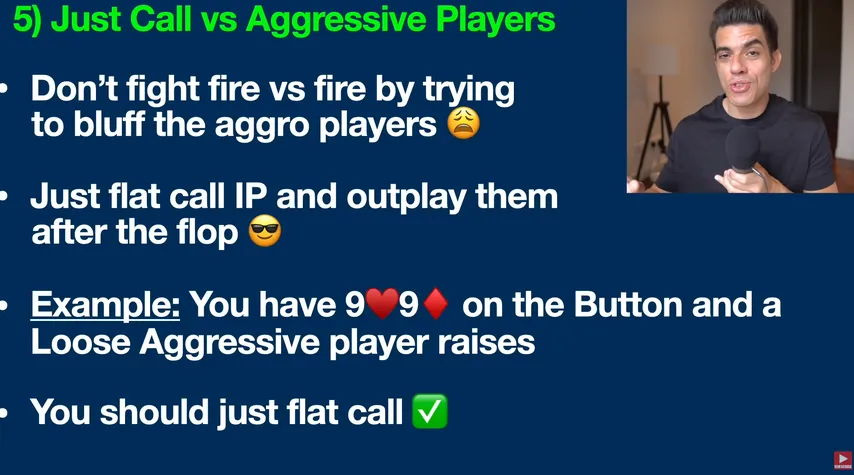
I have found that the best way to beat overly aggressive, bluffy players like this when you have one of these good but not great hands is to just call, cap the size of the betting, and simply outplay them after the flop. We’ll talk more about that in a few minutes.
#5.5 : Play the Right Hands
I've put up some basic charts here on your screen for both six-player and nine-player games. Six-player poker games are much more popular online these days, but nine-player games are still routinely played all over the world, especially in live casinos.
In a six-player poker game, I typically suggest playing around the top 20% of all hands dealt to you; that is all hands in red on your screen. This includes all pocket pairs, most Broadway cards (any two cards ten and above), most suited aces, and a lot of suited connectors. In a nine-player game, I suggest playing only the top 15% of your hands, as you can see on your screen there.
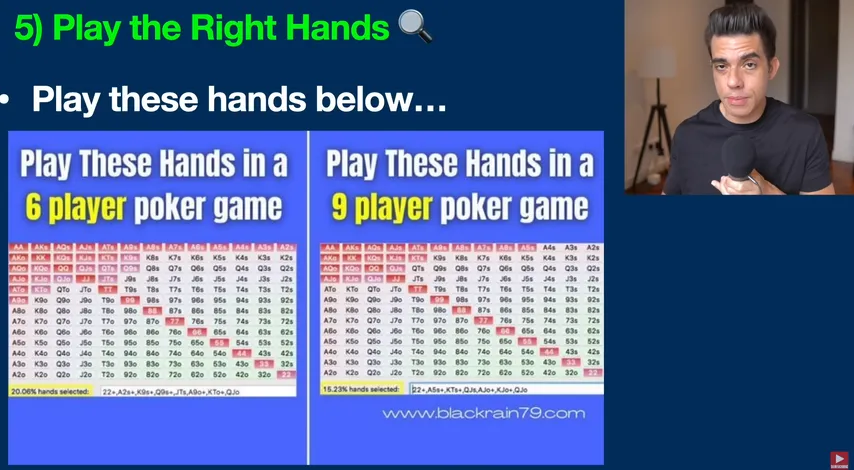
A lot of people ask me why there’s a difference. The reason I suggest playing 5% fewer hands in a nine-player game is that when there are more players at the table, logically, the chances that somebody has something good go up because there are simply more players at the table. Therefore, you want to have stronger starting hand selection in this situation.
Bottom line: if you are relatively new to poker, I recommend studying charts like this. Stick to these hands only for now; you'll have a strong mathematical advantage entering each hand of poker.
#4: Never Pay Off the Nits
Nits and rocks are the tightest players at the table. There are many of them in today's games; I see them everywhere. They sit around folding every hand while waiting for pocket aces, pocket kings, or ace-king. They only put significant action in when they have a really strong hand—like a flush, top pair, straight, or three-of-a-kind.
You’ve probably seen these players before. Just as we talked about with loose and aggressive players who like to bluff a lot, the same principle applies here: you don’t want to play into their game if you know they’re just sitting there waiting for the best hand possible all the time. If they're folding every single time and playing super disciplined, then it should go without saying that when they finally wake up and start raising or re-raising you, it’s because they have it—not because they’re running some high-level bluff out of nowhere. They’re just playing their hand face up, and you need to adjust accordingly.
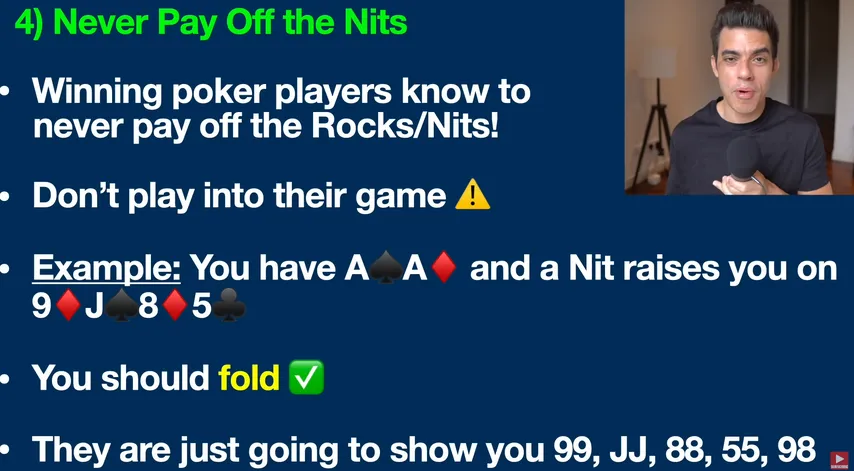
#3: C-Bet Most Flops
All right, guys, let's move on to **tip number three**, which is to c-bet most flops. A c-bet in poker stands for a continuation bet. I have talked about this in many videos on the channel, emphasizing that you should always take control of the pot before the flop. What I mean by that is raising or re-raising. In fact, I made a video just last week showing you how much to make your raises and re-raises; you can check that out.
Bottom line: all good players these days know that you should continue your aggression on the flop by giving your opponents a reason to fold—whether you hit the flop or not.
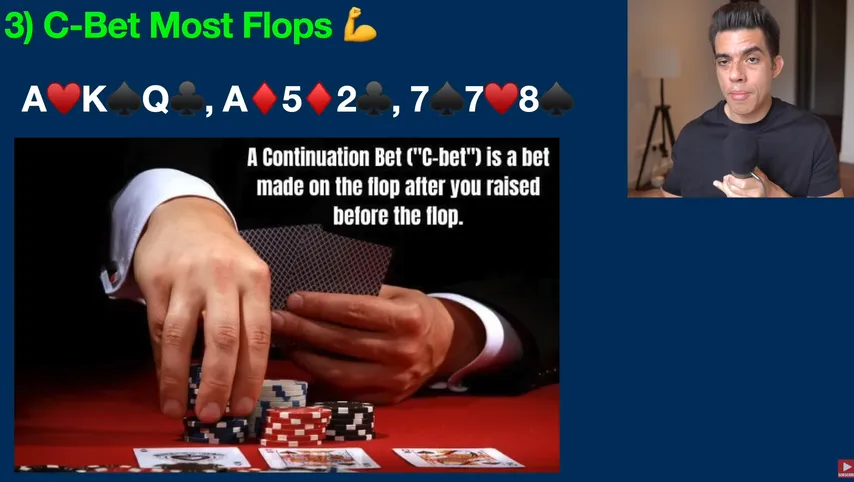
Bottom line: most of the time in poker, if you're up against just one player and you get any of these common sorts of flops—even if you have nothing—you very often want to make another bet. Always remember: aggressive poker is winning poker!
Give them a reason to fold; don’t just check. That is how you're going to have the most success in this game.
#2: Only Slowplay vs Aggressive Players
Building off what we just discussed, let me explain slow play. Slow playing is when you check with a big hand. For example, if you've got and the flop comes down with , we already talked about this situation before: we have top pair with top kicker here, which is an extremely strong hand. Remember, if they have something like , we’re about 87% to win in this situation.
Unless they have one of those extremely rare hands like two pair, trips, or a set that beats us here, we have by far the best hand. In this situation, this is one of the only spots where I will sometimes check against an aggressive player because I know there's a strong likelihood that they will bluff at it with a hand like for example—with bottom pair. If I just make a big bet or raise here, they might fold their hands, which doesn’t help us because we're not getting any more value from that hand.
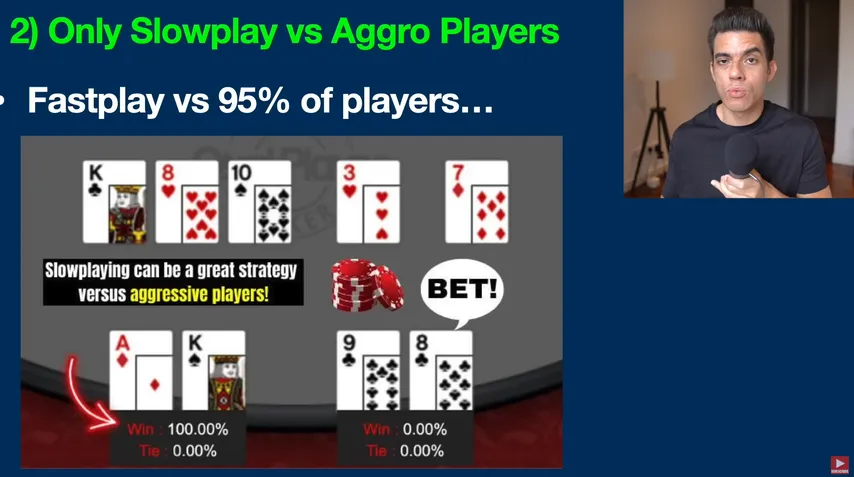
I want to be clear here: I only use this strategy against highly aggressive players. If we're up against passive nits and rocks—the type of players we just talked about—I am literally never going to slow play because I know they're just going to check behind, which keeps the pot low. We don't win in poker by winning tiny pots; this is a huge mistake that many amateurs make.
So guys, against 95% of players in today’s games, you just want to fast-play your hand here—making a big bet as we discussed earlier. But against those handful (5%) of hyper-aggressive players who love to bluff all the time, I will sometimes play my hands slow in situations like this to give them enough rope to hang themselves.
#1: Fix Your Red Line
The red line is a key statistic that you get from many poker tracking programs these days—such as PokerTracker—which I have used for over ten years as a professional player.
In a nutshell, the red line represents your non-showdown winnings. What you need to understand about poker—I'm sure this isn't news to you—is that over the long run, you will receive a mix of good hands, mediocre hands, and bad hands. The only difference between the handful of elite players and everyone else is how they play their mediocre and bad hands. This is honestly what people have most of the time.
Basically, when you don't have much at all—which is the case in 90% of pots in Texas Hold'em—nobody really has anything. The elite players get ahead by taking away more of these pots. We've already touched on a couple of ways to do this earlier in this video: using bluff raises and stealing the blinds. I've discussed how to make bluff raises on the flop in many other videos here on the channel.
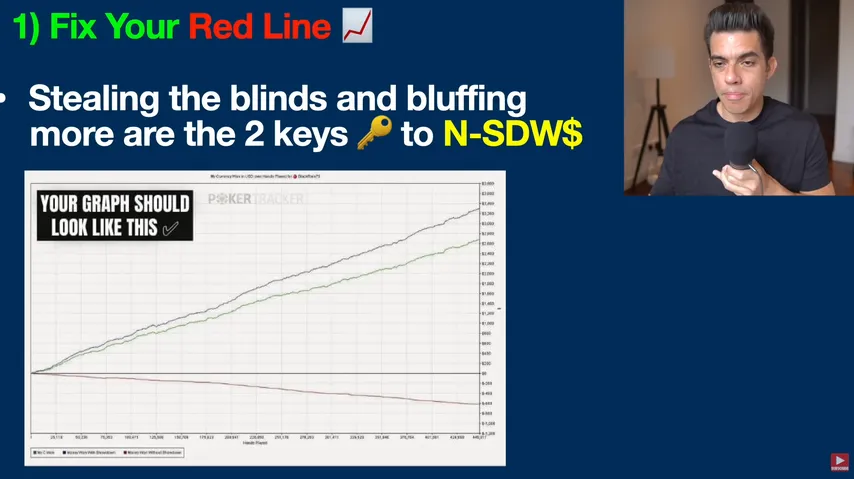
Bottom line: do not be one of those passive players who sit around waiting to hit the nuts all the time, hoping for the best hand possible. That is a losing strategy in poker because good hands do not come around very often. You need to be stealing the blinds and bluffing sometimes in the right situations so that your red line is roughly break-even or slightly positive. You don't want your red line to be massively winning because that means you are bluffing too much, which likely leads to being called down by any sensible poker player and starting to hemorrhage money. But that is a topic for another video.
In summary, focus on improving your non-showdown winnings by being aggressive and taking control of pots when you have the opportunity. This approach will help you maintain a healthy red line and ultimately contribute to your overall success in poker









